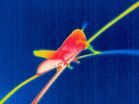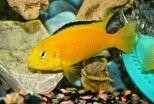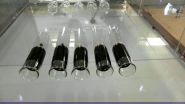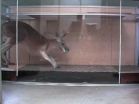(Press-News.org) Theorists propose a way to make superconducting quantum devices such as Josephson junctions and qubits, atom-by-atom, inside a silicon crystal. Such systems could combine the most promising aspects of silicon spin qubits with the flexibility of superconducting circuits. The researcher's results have now been published in Nature Communications (1).
High quality silicon is one of the historical foundations of modern computing. But it is also promising for quantum information technology. In particular, electron and nuclear spins in pure silicon crystals have been measured to have excellent properties as long-lived qubits, the equivalent of bits in conventional computers.
In a paper appearing this week in Nature Communications, Yun-Pil Shim and Charles Tahan from the University of Maryland and the Laboratory for Physical Sciences (on the College Park, MD campus) have shown how superconducting qubits and devices can be constructed out of silicon (2). Doing so can potentially combine the good quantum properties of silicon and the ubiquity of semiconductor technology with the flexibility of superconducting devices. They propose using "bottom-up" nano-fabrication techniques to construct precisely placed superconducting regions within silicon or germanium and show that such "wires" can be used to make superconducting tunnel junctions and other useful superconducting devices.
Qubits in superconductors and semiconductors
Superconducting circuits, made from superconducting metals and Josephson tunnel junctions (which allow superconducting electron pairs to tunnel between two superconductors), are exceptionally customizable and can produce devices ranging from magnetic field sensors to classical logic circuits. They are also likely to play a big role in processing quantum information, where they can be used as a platform for qubits, tiny quantum systems which reside in a superposition of quantum states.
Several types of superconducting circuits have been used to implement qubits and quantum logic gates with different properties and potential uses. For example, in one kind of circuit current can flow in either of two directions. These alternatives constitute the two superposed states needed for establishing a qubit. The two states can be labeled "0" and "1" in analogy with classical bits. Microwave pulses can drive transitions between the two levels allowing for quantum logic gates.
In general, quantum systems are delicate objects and are susceptible to noise and other environmental factors which diminish performance. Prospective quantum circuits must preserve qubits from outside interference for as long as the quantum calculation proceeds. Despite rapid progress in the quality of superconducting qubits (qubit lifetimes can now surpass 100 microseconds), qubit gate error rates are still limited by loss in the metals, insulators, substrates, and interfaces that make up the heterogeneous superconducting devices.
Spin qubits, are an example of qubits realized in a solid-state, silicon context. Spin is a quantum property of particles like an electron; physicists often think of an electron's spin as being like a small magnet, which will naturally point along the direction of an applied magnetic field. Here the 0 and the 1 states correspond to the two possible orientations of the electron spin, either up or down. Because spin is naturally decoupled from charge in some systems (meaning the information stored in the direction of the spin will not be ruined by moving the electron or by it being shaken by electric noise), spin qubits are thought to be promising candidates for a robust qubit design. Further, the use of epitaxial semiconductor devices, and the ability to bury spin qubits deep inside a semiconductor medium, far away from noise at interfaces and surfaces, has resulted in qubits that live for seconds or even hours in some situations, much longer than superconducting qubits to date.
Practical devices
Shim and Tahan propose to use the best features of superconductor and semiconductor qubits. They aim to make superconducting wires and junctions, from which qubits and sensors can be made, by placing (or "doping") acceptor atoms (such as boron or aluminum, elements which readily accept extra electrons) in silicon in precise regions within the crystal. They suggest that a recently developed technique from the silicon qubit community, "STM hydrogen lithography", can be used to do just that. Pioneered by Michelle Simmons at the University of New South Wales, a scanning tunneling microscope (STM) tip is used to selectively remove hydrogen atoms on the surface of silicon (or germanium). Doping gas such as phosphine can then be introduced, allowing the selective placement of impurities down to a single atomic site. "If acceptor atoms can be placed at sufficient density over enough layers, then superconducting regions can be fabricated within the silicon and then encapsulated with crystalline silicon," says Dr. Shim.
In some STM efforts as many as one-in-four silicon atoms have been replaced in this manner. And generally the higher the dopant density, the higher the critical superconducting temperature will be.
Scientists first learned about 10 years ago that silicon can be made superconducting if doped to sufficient density with acceptor atoms such as boron. In recent years, the quality of such superconducting silicon systems has improved greatly, yielding material with superconducting critical temperatures approaching 1 Kelvin and still leaving the crystal in good condition (in other words, it's still silicon).
By calculating the properties of these superconducting-semiconductor regions, Shim and Tahan show that wires with sufficient critical temperature can be constructed practically with the bottom-up hydrogen lithography approach. They also show that Josephson tunnel junctions and weak links, the fundamental non-linearity from which superconducting circuits can be constructed, can also be made. Finally they show that the previously-demonstrated superconducting qubit types (seen in metal samples) can be constructed in this silicon system as well and provide the geometric requirements needed for fabrication.
"There is ongoing effort to make the tunneling barrier epitaxial to improve its quality," said Charles Tahan, "but no previous work to make the whole device out of a single semiconductor crystal. As far as we know, this is the first proposal on the feasibility of SC silicon for Josephson junctions and qubits. I'm also excited about these systems' potential for other devices such as sensors and particle detectors."
Beyond the possibility of superconducting circuits built inside a homogeneous silicon crystal, engineered superconducting-semiconductor devices like these could be used to build other types of exotic quantum many-body systems, at the atomic scale, and even act as testbeds for our understanding of superconductivity itself.
INFORMATION:
(1) "Bottom-up superconducting and Josephson junction devices inside a Group-IV semiconductor," Yun-Pil Shim and Charles Tahan. Nature Communications (2014), published online ZZZ July 2014. DOI: 10.1038/ncomms5225. On arXiv:1309.0015
(2) The Laboratory for Physical Sciences is affiliated with the Joint Quantum Institute (JQI).
Charles Tahan, ctahan@lps.umd.edu; Yun Pil Shim, ypshim@umd.edu
Press contact at JQI: Phillip F. Schewe, pschewe@umd.edu. http://jqi.umd.edu/
Superconducting-silicon qubits
Using a bottom-up approach to make hybrid quantum devices
2014-07-02
ELSE PRESS RELEASES FROM THIS DATE:
From despair to repair: Dramatic decline of Caribbean corals can be reversed
2014-07-02
Gland, Switzerland – With only about one-sixth of the original coral cover left, most Caribbean coral reefs may disappear in the next 20 years, primarily due to the loss of grazers in the region, according to the latest report by the Global Coral Reef Monitoring Network (GCRMN), the International Union for Conservation of Nature (IUCN) and the United Nations Environment Programme (UNEP).
The report, Status and Trends of Caribbean Coral Reefs: 1970-2012, is the most detailed and comprehensive study of its kind published to date – the result of the work of 90 experts over ...
License plate readers are important police tool, but hurdles remain, study finds
2014-07-02
Systems that automatically read automobile license plates have the potential to save police investigative time and increase safety, but law enforcement officials must address issues related to staffing, compatibility and privacy before the technology can reach its full potential, according to a new RAND Corporation report.
As part of efforts to promote innovation in law enforcement, many of the first generation license plate reader systems were purchased with federal and state grants. As these funding streams can be inconsistent, law enforcement agencies are – or will ...
A 'magic moment' for unwed parents
2014-07-02
DURHAM, N.C. -- If unwed parents are going to get married, the best window of opportunity for that union seems to be before their child turns 3, says a new study from Duke University.
But patterns vary greatly by race, with more African-American mothers marrying much later than mothers of other races or ethnicities.
Federal policies have often presumed that unmarried parents will be most receptive to marriage right after a baby's birth, a period that has been dubbed the "magic moment." The new study is the first to test that assumption, said author Christina Gibson-Davis. ...
How do ants get around? Ultra-sensitive machines measure their every step…
2014-07-02
How do ants manage to move so nimbly whilst coordinating three pairs of legs and a behind that weighs up to 60% of their body mass? German scientists have recently developed a device that may reveal the answer.
Measuring the forces generated by single limbs is vital to understanding the energetics of animal locomotion. However, with very small animals such as insects, this becomes problematic. Dr Reinhardt (Friedrich-Schiller University) used an elastic polycarbonate material to produce a miniature force plate. Springs arranged at right angles to each other enabled forces ...
Locusts harness the sun to get their optimum diet
2014-07-02
If you are a locust, the most nutritious plant to eat depends on the ambient temperature. Scientists at the University of Sydney, Australia, have discovered that locusts choose their food and then where they digest it according to how hot it is.
Dr Fiona Clissold, who led the study, explains why temperature has such a large influence on insect diets. "Whilst an insect's metabolic rate increases exponentially with temperature, the rate at which locusts absorb protein and carbohydrate from different plants does not increase in step with temperature. As a result, nutrient ...
Smarter than you think: Fish can remember where they were fed 12 days later
2014-07-02
It is popularly believed that fish have a memory span of only 30 seconds. Canadian scientists, however, have demonstrated that this is far from true – in fact, fish can remember context and associations up to twelve days later.
The researchers studied African Cichlids (Labidochromis caeruleus), a popular aquarium species. These fish demonstrate many complex behaviours, including aggression, causing the scientists to predict that they could be capable of advanced memory tasks. Each fish was trained to enter a particular zone of the aquarium to receive a food reward, with ...
A sheep's early life experiences can shape behavior in later life
2014-07-02
New research has found that a sheep's experiences soon after birth can shape its later behaviour and also that of its offspring.
The study led by academics from the University of Bristol's School of Veterinary Sciences and published in the Royal Society journal Biology Letters investigated whether early-life experiences can alter behavioural responses to a naturally painful event in adulthood – giving birth – and also affect behaviour of the next generation.
The period following birth can be a challenging time for young lambs. They are usually tail-docked without analgesia ...
Patients with severe ME have little or no access to specialist treatment services
2014-07-02
One in three severely affected adults with ME in England have no access to local specialist services, new research has shown.
Published in the British Medical Journal Open, the research by the University of Southampton reveals NICE guidelines, which say severely affected patients with ME, otherwise known as chronic fatigue syndrome (CFS), should have access to specialist care, are not being met by many NHS Trusts across England.
Over a third of specialist adult ME/CFS services in the NHS provide no service to severely affected patients, and a further 12 per cent of ...
Nature of solids and liquids explored through new pitch drop experiment
2014-07-02
VIDEO:
The movie clip shows the bitumen flow from the top camera view, and corresponds to approximately 24 days of real time.
Click here for more information.
Physicists at Queen Mary University of London have set up a new pitch drop experiment for students to explore the difference between solid and liquids.
Known as the 'world's longest experiment', the set up at the University of Queensland was famous for taking ten years for a drop of pitch – a thick, black, sticky ...
New study involving CU-Boulder tells the tale of a kangaroo's tail
2014-07-02
VIDEO:
This video is an analysis of video of kangaroos walking has helped scientists discover how important their tails are during locomotion.
Click here for more information.
Kangaroos may be nature's best hoppers. But when they are grazing on all fours, which is most of the time, their tail becomes a powerful fifth leg, says a new study.
Involving researchers at the University of Colorado Boulder, Simon Fraser University in Burnaby, Canada, and the University of New ...
LAST 30 PRESS RELEASES:
Groundbreaking discovery turns household plastic recycling into anti-cancer medication
Blocking a key inflammatory pathway improves liver structure and vascular function in cirrhosis, study finds
Continuous spread: Raccoon roundworm detected in nine European countries
HKUST Engineering researchers developed a novel photodetector to enhance the performance of on-chip light monitoring
Strategic river sensors could have forewarned of Texas Camp flood disaster
Drone sampling of whale breath reveals first evidence of potentially deadly virus in Arctic
Roman soldiers defending Hadrian’s Wall infected by parasites, study finds
Pinochet’s prisoners were tormented with music but still found solace in it, a new book reveals
Fertility remains high in rural Tanzania despite access to family planning
AI-assisted device can improve autism care access
Kinetic careers
Uncovering how parasitic plants avoid attacking themselves to improve crop resistance
Nanoparticle vaccine strategy could protect against Ebola and other deadly filoviruses
Study finds brain care score can predict risk of stroke across racial groups
Key lung immune cells can intensify allergic reactions
Do hormones explain why women experience more gut pain?
New materials conduct ions in solids as easily as in liquids
Breakthrough of the Year: Renewable energy begins to eclipse fossil fuel-based sources
LLM use is reshaping scientific enterprise by increasing output, reducing quality and more
Introducing LightGen, a chip for ultra-fast, ultra-efficient generative AI
Astronomers see fireworks from violent collisions around nearby star
ACC/AHA issue new guideline on managing congenital heart disease in adults
Cosmic crash caught on camera
Is talented youth nurtured the wrong way? New study shows: top performers develop differently than assumed
Ants: An untapped resource in the development of antibiotics?
Archaeologists use AI to create prehistoric video game
Mitochondria migrate toward the cell membrane in response to high glucose levels
Tiny viral switch offers hope against drug-resistant bacteria
Most parents aware of early peanut introduction guidelines, but confused about details
HPV vaccine can protect against severe lesions of the vulva and vagina
[Press-News.org] Superconducting-silicon qubitsUsing a bottom-up approach to make hybrid quantum devices




